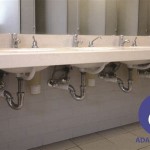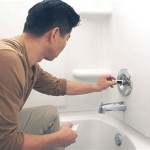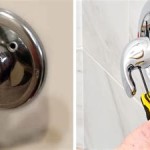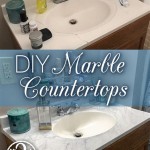How To Cover Bathroom Sink Pipes: A Comprehensive Guide
Exposed plumbing under a bathroom sink can detract from the overall aesthetic of the space. While functionality is paramount, the visual appeal of a bathroom is significantly influenced by its design elements. Unsightly pipes, often a mix of chrome, PVC, and connectors, disrupt the clean lines and cohesive style that many homeowners strive to achieve. Covering these pipes is a common home improvement project that balances practicality with visual enhancement.
The process of concealing bathroom sink pipes involves several methods, ranging from simple and inexpensive solutions to more elaborate and permanent fixes. The choice of method depends on factors such as budget, skill level, the existing bathroom decor, and the desired level of concealment. Before undertaking any project, it is crucial to consider accessibility for future plumbing repairs. A solution that completely encases the pipes without allowing for easy access can create significant problems in the event of a leak or other plumbing issue.
This article will provide a detailed exploration of various techniques for covering bathroom sink pipes. It will delve into the advantages and disadvantages of each approach, offering practical guidance on materials, installation, and maintenance considerations. The goal is to equip homeowners with the knowledge necessary to select the most appropriate solution for their specific needs and to successfully execute the project, resulting in a more aesthetically pleasing and functional bathroom space.
Choosing the Right Method for Covering Pipes
Selecting the optimal method for concealing bathroom sink pipes requires careful consideration of several factors. The existing bathroom design, the homeowner's budget, and the level of DIY skill all play a role in determining the most suitable solution. A thorough assessment of these factors is essential before proceeding with any actual work.
The existing bathroom design is a primary consideration. The chosen method should complement the overall style of the bathroom, whether it is modern, traditional, or eclectic. A sleek, contemporary bathroom might benefit from a minimalist approach, such as a simple pipe cover or a custom-built cabinet. A more traditional bathroom might be better suited to a decorative skirt or a vintage-inspired vanity. Matching the concealment method to the existing aesthetic will create a cohesive and visually appealing result.
Budget constraints are also a significant factor. Some solutions, such as purchasing pre-fabricated pipe covers or installing a sink skirt, are relatively inexpensive and easy to implement. Others, such as building a custom cabinet or hiring a professional plumber to reroute the pipes, can be considerably more costly. Homeowners should carefully evaluate their budget and determine how much they are willing to spend on this project. It is important to factor in the cost of materials, tools, and potentially, professional labor.
The homeowner's DIY skill level is another crucial consideration. Some methods, such as installing a pipe cover or attaching a fabric skirt, are relatively simple and can be easily accomplished by novice DIYers. Others, such as building a custom cabinet or rerouting plumbing, require more advanced skills and experience. It is important to be realistic about one's own abilities and to choose a method that is within one's comfort zone. Attempting a project that is beyond one's skill level can lead to frustration, wasted materials, and potentially, costly mistakes.
Accessibility for future repairs is a final, but crucial, factor. Whatever method is chosen, it is essential to ensure that the pipes remain easily accessible for future maintenance and repairs. Completely encasing the pipes without leaving any access points can create significant problems in the event of a leak or other plumbing issue. It is advisable to choose a method that allows for easy removal or access to the pipes, such as a removable panel in a cabinet or a skirt that can be easily lifted.
Popular Pipe Covering Solutions
There are several popular methods for covering bathroom sink pipes, each offering its own set of advantages and disadvantages. These methods range from simple and affordable options to more elaborate and permanent solutions. Understanding the characteristics of each method will help homeowners make an informed decision based on their specific needs and preferences.
One of the simplest and most affordable options is using pre-fabricated pipe covers. These covers are typically made of plastic or metal and are designed to snap or clip onto the pipes, concealing them from view. They are available in a variety of colors and styles to match different bathroom decors. Pipe covers are easy to install and require no special tools or skills. However, they may not be suitable for all pipe configurations and may not provide complete concealment, especially in cases where the pipes are irregularly shaped or positioned.
Another popular option is to install a sink skirt. A sink skirt is a fabric panel that is attached to the edge of the sink or vanity and hangs down to the floor, concealing the pipes behind it. Sink skirts are available in a wide range of fabrics, colors, and patterns, making it easy to find one that complements the existing bathroom decor. They are relatively easy to install, typically using Velcro or other adhesive fasteners. Sink skirts offer a soft and decorative way to conceal the pipes, but they may not be suitable for all bathroom styles, especially those that are more modern or minimalist.
Building a custom cabinet or vanity is a more elaborate and permanent solution. This involves constructing a cabinet or vanity that encloses the pipes and provides additional storage space. Custom cabinets can be designed to fit any bathroom style and can be made from a variety of materials, such as wood, laminate, or metal. Building a custom cabinet requires more advanced skills and tools than the other methods, but it offers a high level of concealment and allows for complete customization. However, it is also the most expensive option and may not be feasible for all homeowners.
Rerouting the plumbing is another possibility, although it is typically the most expensive and complex solution. This involves hiring a professional plumber to reroute the pipes so that they are less visible or completely hidden behind the wall. Rerouting the plumbing can be a good option for homeowners who are undertaking a major bathroom renovation and want to completely eliminate the unsightly pipes. However, it is important to note that this method can be costly and may require opening up the walls, which can be disruptive and time-consuming.
Decorative wraps or paint are a less common solution, but can be effective in certain circumstances. Decorative wraps, often made of vinyl or a similar material, can be applied directly to the pipes to conceal them with a pattern or solid color. Painting the pipes a color that matches the wall behind them can also help them blend in and become less noticeable. These methods are relatively inexpensive and easy to implement, but they may not provide complete concealment and may not be suitable for all pipe materials.
Step-by-Step Installation Guides for Common Methods
The installation process for covering bathroom sink pipes varies depending on the chosen method. This section provides step-by-step guides for some of the most common and accessible techniques. These guides are intended to provide a general overview of the installation process; specific instructions will vary depending on the materials and tools used.
Installing Pre-fabricated Pipe Covers:
1.
Measure the pipes:
Before purchasing pipe covers, accurately measure the diameter and length of the pipes that need to be covered. This will ensure that you purchase the correct size covers.2.
Purchase pipe covers:
Select pipe covers that are the appropriate size and style for your bathroom. Consider the color, material, and design of the covers to ensure they complement the existing decor.3.
Clean the pipes:
Thoroughly clean the pipes to remove any dust, dirt, or grime. This will help the pipe covers adhere properly.4.
Install the covers:
Depending on the type of pipe cover, you may need to snap, clip, or slide them onto the pipes. Follow the manufacturer's instructions carefully to ensure proper installation.5.
Secure the covers:
If necessary, use adhesive or fasteners to secure the covers in place. This will prevent them from shifting or falling off.Installing a Sink Skirt:
1.
Measure the sink:
Measure the width and height of the area under the sink that you want to cover with the skirt. This will determine the size of the fabric panel needed.2.
Select fabric:
Choose a fabric that complements the existing bathroom decor. Consider the color, pattern, and texture of the fabric, as well as its durability and ease of cleaning.3.
Cut the fabric:
Cut the fabric to the appropriate size, adding a few inches for hemming. Hem the edges of the fabric to prevent fraying.4.
Attach fasteners:
Attach Velcro or other adhesive fasteners to the top edge of the fabric panel. Also, attach the corresponding fasteners to the edge of the sink or vanity.5.
Attach the skirt:
Align the fasteners on the fabric panel with the fasteners on the sink or vanity and press firmly to attach the skirt. Ensure that the skirt hangs evenly and conceals the pipes completely.Painting the Pipes:
1.
Prepare the pipes:
Clean the pipes thoroughly, removing any dirt, grime, or rust. Lightly sand the pipes to create a better surface for the paint to adhere to.2.
Prime the pipes:
Apply a coat of metal primer to the pipes. This will help the paint adhere better and prevent rust.3.
Paint the pipes:
Once the primer is dry, apply one or two coats of paint to the pipes, using a color that matches the wall behind them. Allow the paint to dry completely between coats.4.
Apply a sealant (optional):
For added protection, apply a clear sealant to the painted pipes. This will help prevent chipping and fading.These step-by-step guides provide a general overview of the installation process for common methods of covering bathroom sink pipes. Always refer to the manufacturer's instructions for specific guidance and safety precautions.

How To Hide Plumbing In Your Bathroom Victoriaplum Com

Pin On Layouts

How To Hide Pipes On A Small Floating Si Bunnings Work Community

Pin On Bathroom

How To Hide Plumbing In Your Bathroom Victoriaplum Com

Creative Ways To Utilise The Under Sink Areas In Your Bathroom And Kitchen Hipcouch Complete Interiors Furniture

Whats Some Ways To Cover Up My Sink Pipes Hometalk

Ask A Builder Hiding Pipes

Boxing In Bathroom Pipework Guru

5 Ways To Conceal A Waste Pipe Under Vanity The Plumbette
Related Posts







